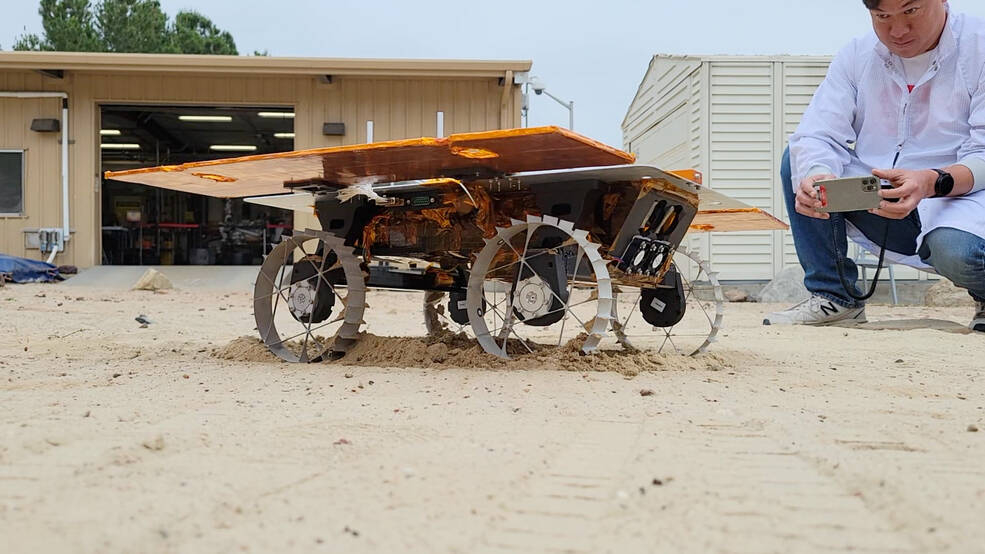Trio of tiny autonomous NASA rovers will launch to the moon next year
The three spacecraft will be unleashed on the moon with only high-level orders.

A trio of miniature autonomous NASA rovers will soon head for the moon, with the aim of boosting the efficiency of exploration missions.
The four-wheeled, carry-on-suitcase-sized moon rovers — known as Cooperative Autonomous Distributed Robotic Exploration (CADRE) — will work as a team and carry out tasks with only initial, high-level input from humans.
The intrepid trio will travel to the moon aboard Intuitive Machines' third lunar lander, IM-3, as part of NASA's Commercial Lunar Payload Services (CLPS) initiative. Launch is scheduled for 2024.
Related: Missions to the moon: Past, present and future
The mission will target the intriguing Reiner Gamma region, one of a number of mysterious lunar swirls with an associated local magnetic field.
The Reiner Gamma swirl is located in Oceanus Procellarum ("Ocean of Storms"), on the western edge of the near side of the moon and just north of the equator, where midday temperatures could reach up to 237 degrees Fahrenheit (114 degrees Celsius).
CADRE's rovers will be lowered onto the surface of the moon via tethers and find a spot to catch sunlight and charge their batteries. They will then spend the rest of the roughly 14-Earth-day-long lunar daytime carrying out experiments in order to test their capabilities.
Get the Space.com Newsletter
Breaking space news, the latest updates on rocket launches, skywatching events and more!
While their mission will be brief, it could influence exploration in the long term. By taking simultaneous measurements from multiple locations, the rovers will seek to demonstrate how multi-robot missions could potentially enable new science or support astronauts.
"Our mission is to demonstrate that a network of mobile robots can cooperate to accomplish a task without human intervention — autonomously," said Subha Comandur, the CADRE project manager at NASA's Jet Propulsion Laboratory in Southern California, in a statement.
"It could change how we do exploration in the future. The question for future missions will become: 'How many rovers do we send, and what will they do together?'" Comandur added.
The trio will receive orders from their lunar lander, divide tasks among themselves and decide how to execute their plans safely.
"The only instruction is, for example, 'Go explore this region,' and the rovers figure out everything else: when they'll do the driving, what path they'll take, how they'll maneuver around local hazards," said JPL's Jean-Pierre de la Croix, CADRE's principal investigator.
"You only tell them the high-level goal, and they have to determine how to accomplish it."
The rovers will carry out their roles under the gaze of a monitoring camera atop the 13-foot-tall (4 meters) lander. These roles include driving in formation and avoiding obstacles, with each robot exploring a patch of lunar surface covering 4,300 square feet (400 square meters) while using stereo cameras to create a topographic 3D map. The rovers also carry ground-penetrating radars, which will provide a glimpse as far as 33 feet (10 m) into the subsurface.
A successful run will show that a multi-spacecraft approach could help us explore hazardous but scientifically rewarding planetary body terrain, mission team members said
CADRE is one of four sets of payloads flying on IM-3. The Nova-C Lander will launch on a SpaceX Falcon 9 rocket and carry a total mass of roughly 203 pounds (92 kilograms) of investigative mission payloads.
Join our Space Forums to keep talking space on the latest missions, night sky and more! And if you have a news tip, correction or comment, let us know at: community@space.com.

Andrew is a freelance space journalist with a focus on reporting on China's rapidly growing space sector. He began writing for Space.com in 2019 and writes for SpaceNews, IEEE Spectrum, National Geographic, Sky & Telescope, New Scientist and others. Andrew first caught the space bug when, as a youngster, he saw Voyager images of other worlds in our solar system for the first time. Away from space, Andrew enjoys trail running in the forests of Finland. You can follow him on Twitter @AJ_FI.









